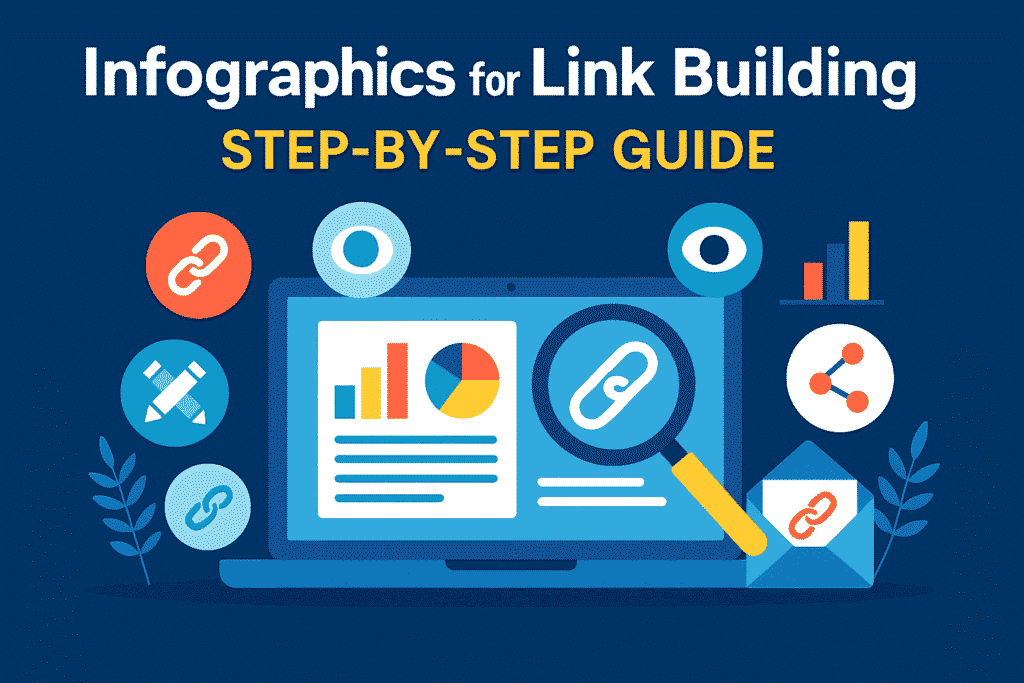
Contents
Did you know that infographics are 30x more likely to be read than text-only content? In today’s digital landscape, where attention spans are shrinking, visual content has become a powerful tool for engagement—and more importantly, for link building.
High-quality backlinks remain one of the strongest ranking factors in SEO. However, earning them isn’t easy. That’s where infographics come in. They combine eye-catching design with valuable data, making them highly shareable and link-worthy content.
Before making infographics, read How to Create Link-Worthy Content to learn how to design content people want to link to.
In this article, you’ll learn:
- Why infographics are a secret weapon for link building.
- A step-by-step process to create and promote infographics for backlinks.
- Pro tips to maximize results and track success.
Let’s dive in!
Why Infographics Are Powerful for Link Building?
Before jumping into the how-to, let’s understand why infographics work so well for earning backlinks:
1. Visuals Get More Engagement
- The human brain processes images 60,000x faster than text.
- Infographics generate 3x more shares than other content types.
2. Naturally Linkable Format
- Bloggers, journalists, and educators love citing infographics because they simplify complex data.
- Websites that reference statistics often link back to the original source (your infographic).
3. Boosts Brand Authority
- A well-researched infographic positions your brand as an industry expert.
- When others share it, your brand gains free exposure and credibility.
4. Evergreen Link-Bait
- Unlike news articles, a high-quality infographic can keep earning backlinks for years.
Now, let’s break down the step-by-step process to leverage infographics for link building.
Step 1: Research & Topic Selection
The success of your infographic depends on choosing the right topic. Here’s how to pick a winner:
A. Find Trending & Relevant Topics
- Use Google Trends, BuzzSumo, or AnswerThePublic to see what’s popular in your niche.
- Look for data-heavy topics (e.g., “Statistics on Remote Work in 2024”).
B. Identify Content Gaps
- Check competitors’ infographics—can you create something better?
- Search for “your keyword + infographic” to analyze competition.
C. Target SEO Keywords
- Use Ahrefs, SEMrush, or Ubersuggest to find low-competition, high-traffic keywords.
- Example: Instead of “SEO tips,” target “SEO statistics 2024 [Infographic]”.
Step 2: Design an Engaging Infographic
A poorly designed infographic won’t attract links. Follow these best practices:
A. Choose the Right Tools
- Free: Canva, Piktochart, Venngage
- Advanced: Adobe Illustrator, Figma
B. Structure for Maximum Impact
- Headline: Clear, benefit-driven (e.g., “How AI is Changing Marketing [2024 Data]”).
- Data Visualization: Use charts, icons, and comparisons for easy digestion.
- Color & Branding: Stick to 2-3 colors + include your logo and URL.
- Sources & Citations: Adds credibility and encourages backlinks.
C. Optimize for SEO
- File Name:
seo-statistics-2024-infographic.png(notimage123.png). - Alt Text: Describe the infographic for search engines.
- Compress Image: Use TinyPNG to reduce load time.
Step 3: Publish & Optimize for Maximum Reach
Your infographic won’t build links if it’s just sitting on your site. Here’s how to publish it effectively:
A. Create a Dedicated Blog Post
- Write a 300-500 word introduction explaining the infographic.
- Include an embed code (so others can share it easily).
B. Submit to Infographic Directories
- Visual.ly
- Daily Infographic
- Infographic Journal
C. Share on Social Media
- Pinterest: Ideal for infographics (use keywords in the pin description).
- LinkedIn & Twitter: Tag influencers who might share it.
- Facebook Groups & Reddit: Share in relevant communities.
Step 4: Promote for Backlinks (Outreach Strategy)
This is where most people fail—they don’t actively seek backlinks. Here’s how to do it right:
A. Find Link Prospects
- Use Ahrefs’ Backlink Gap Tool to see who links to competitors’ infographics.
- Search for “write for us” + your niche to find guest post opportunities.
B. Craft a Personalized Outreach Email
Here is an Example of an outreach email:
“Hi [Name],
I noticed your recent article on [Topic]. My team just published an infographic on [Related Data] that could add value to your readers.
Here’s the link: [URL]
Would you consider adding it to your post? I’d be happy to share it with my audience as well!
Best,
[Your Name]”*
C. Leverage Broken Link Building
- Use Check My Links (Chrome extension) to find broken infographics.
- Email site owners suggesting yours as a replacement.
Step 5: Track & Measure Success
To ensure your efforts pay off, track these metrics:
A. Backlinks Gained
- Tools: Ahrefs, Moz, Google Search Console
B. Traffic from Infographics
- Google Analytics → Behavior → Landing Pages
C. Social Shares & Embeds
- BuzzSumo to monitor shares.
Pro Tips for Better Results
- Repurpose Old Infographics
- Turn them into videos, slideshows, or Twitter threads.
- Collaborate with Influencers
- Co-create infographics for wider reach.
- Update & Re-Promote
- Refresh outdated data and re-share annually.
After creating your infographic, use tips from Link Building Outreach Emails That Get Replies to promote it.
Conclusion
Infographics are one of the most effective ways to earn high-quality backlinks. By following this step-by-step guide, you can:
- Create visually appealing, data-driven infographics
- Publish and optimize them for SEO
- Promote strategically to earn backlinks
- Track performance and refine your strategy
Ready to boost your link-building game? Start creating your first infographic today!
